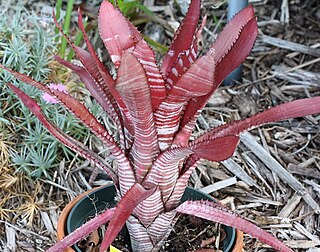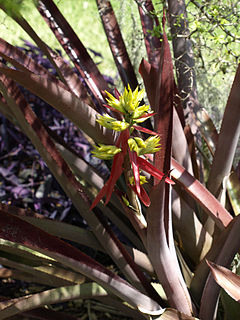Related Research Articles

Aechmea gracilis is a plant species in the genus Aechmea. This species is endemic to southeastern Brazil from Rio de Janeiro State to Santa Catarina.

Aechmea phanerophlebia is a species of flowering plant in the Bromeliaceae family. This species is endemic to Brazil.
Aechmea alba is a species of plant in the genus Aechmea. This species is endemic to Brazil.

Aechmea blumenavii is a plant species in the genus Aechmea. This species is endemic to the state of Santa Catarina, in Brazil.
Aechmea disjuncta is a species in the genus Aechmea. This species is endemic to the State of Bahia in eastern Brazil.

Aechmea emmerichiae is a species in the genus Aechmea. This species is endemic to Chapada Diamantina National Park in eastern Brazil.
Aechmea mutica is a plant species in the genus Aechmea. This species is endemic to the State of Espírito Santo in eastern Brazil.
Aechmea organensis is a plant species in the genus Aechmea. This species is endemic to southeastern Brazil.

Aechmea pedicellata is a plant species in the genus Aechmea. This species is endemic to the State of Espírito Santo in eastern Brazil.
Aechmea pernambucentris is a species in the genus Aechmea. This species is endemic to the State of Pernambuco in eastern Brazil.
Aechmea podantha is a plant species in the genus Aechmea. This species is endemic to the State of Espírito Santo in eastern Brazil.

Aechmea purpureorosea is a plant species in the genus Aechmea. This species is endemic to southeastern Brazil, States of Minas Gerais and Rio de Janeiro.

Aechmea ramosa is a plant species in the genus Aechmea. This species is endemic to eastern Brazil.

Aechmea squarrosa is a species of flowering plant in the Bromeliaceae family'. This species is endemic to the State of Rio de Janeiro in southeastern Brazil.
Aechmea triangularis is a plant species in the genus Aechmea. This species is endemic to the State of Espírito Santo in eastern Brazil.
Aechmea triticina is a plant species in the genus Aechmea. This species is endemic to eastern Brazil, known from the States of Espírito Santo and Rio de Janeiro.

Aechmea warasii is a plant species in the genus Aechmea. This species is endemic to the State of Espírito Santo in eastern Brazil.

Aechmea weilbachii is a plant species in the genus Aechmea. This species is endemic to eastern Brazil, known from the States of Espírito Santo and Rio de Janeiro.
Aechmea werdermannii is a plant species in the genus Aechmea. This species is endemic to eastern Brazil, known from the States of Pernambuco and Alagoas.

Aechmea miniata is a species of flowering plant in the Bromeliaceae family. This species is native to the state of Bahia in eastern Brazil.
References
- ↑ Kew World Checklist of Selected Plant Families
- ↑ Martinelli, Gustavo; Vieira, Cláudia Magalhães; Gonzalez, Marcos; Leitman, Paula; Piratininga, Andréa; Costa, Andrea Ferreira da; Forzza, Rafaela Campostrini (January 2008). "Bromeliaceae da Mata Atlântica Brasileira: lista de espécies, distribuição e conservação" [Bromeliaceae of the brazilian Atlantic Forest: checklist, distribution and conservation]. Rodriguésia (in Portuguese). 59 (1): 209–258. doi: 10.1590/2175-7860200859114 . JSTOR 23499386.